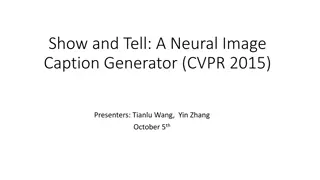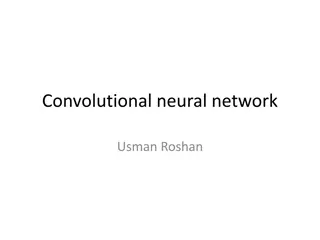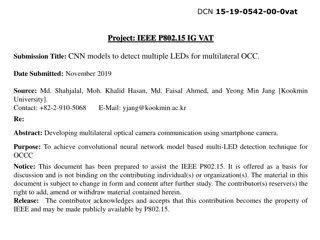Cognitive Load Classification with 2D-CNN Model in Mental Arithmetic Task
Cognitive load is crucial in assessing mental effort in tasks. This paper discusses using EEG signals and a 2D-CNN model to classify cognitive load during mental arithmetic tasks, aiming to optimize performance. EEG signals help evaluate mental workload, although they can be sensitive to noise. The
0 views • 19 slides
Recent Advances in RNN and CNN Models: CS886 Lecture Highlights
Explore the fundamentals of recurrent neural networks (RNNs) and convolutional neural networks (CNNs) in the context of downstream applications. Delve into LSTM, GRU, and RNN variants, alongside CNN architectures like ConvNext, ResNet, and more. Understand the mathematical formulations of RNNs and c
2 views • 76 slides
Recent Developments on Super-Resolution: A Comprehensive Overview
Super-resolution technology aims to reconstruct high-resolution images from low-resolution inputs, with applications in video surveillance, medical diagnosis, and remote sensing. Various convolutional neural network (CNN) models have been developed, such as SRCNN, VDSR, ESPCN, and FSRCNN, each with
0 views • 12 slides
Convolutional Neural Networks: Architectural Characterizations for Accuracy Inference
This presentation by Duc Hoang from Rhodes College explores inferring the accuracy of Convolutional Neural Networks (CNNs) based on their architectural characterizations. The talk covers the MINERvA experiment, deep learning concepts including CNNs, and the significance of predicting CNN accuracy be
1 views • 21 slides
Real-Time Cough and Sneeze Detection Project Overview
This project focuses on real-time cough and sneeze detection for assessing disease likelihood and individual well-being. Deep learning, particularly CNN and CRNN models, is utilized for efficient detection and classification. The team conducted a literature survey on keyword spotting techniques and
1 views • 15 slides
CNN-based Multi-task Learning for Crowd Counting: A Novel Approach
This paper presents a novel end-to-end cascaded network of Convolutional Neural Networks (CNNs) for crowd counting, incorporating high-level prior and density estimation. The proposed model addresses the challenge of non-uniform large variations in scale and appearance of objects in crowd analysis.
1 views • 17 slides
DRONET: Learning to Fly by Driving
DRONET presents a novel approach to safe and reliable outdoor navigation for Autonomous Underwater Vehicles (AUVs), addressing challenges such as obstacle avoidance and adherence to traffic laws. By utilizing a Residual Convolutional Neural Network (CNN) and a custom outdoor dataset, DRONET achieves
0 views • 20 slides
Wavelet-based Scaleograms and CNN for Anomaly Detection in Nuclear Reactors
This study utilizes wavelet-based scaleograms and a convolutional neural network (CNN) for anomaly detection in nuclear reactors. By analyzing neutron flux signals from in-core and ex-core sensors, the proposed methodology aims to identify perturbations such as fuel assembly vibrations, synchronized
3 views • 11 slides
Real-Time Cough and Sneeze Detection Using Deep Learning Models
Detection of coughs and sneezes plays a crucial role in assessing an individual's health condition. This project by Group 71 focuses on real-time detection using deep learning techniques to analyze audio data from various datasets. The use of deep learning models like CNN and CRNN showcases improved
0 views • 15 slides
Convolutional Neural Networks for Sentence Classification: A Deep Learning Approach
Deep learning models, originally designed for computer vision, have shown remarkable success in various Natural Language Processing (NLP) tasks. This paper presents a simple Convolutional Neural Network (CNN) architecture for sentence classification, utilizing word vectors from an unsupervised neura
1 views • 15 slides
Evolution of Sentiment Analysis in Tweets and Aspect-Based Sentiment Analysis
The evolution of sentiment analysis on tweets from SemEval competitions in 2013 to 2017 is discussed, showcasing advancements in technology and the shift from SVM and sentiment lexicons to CNN with word embeddings. Aspect-Based Sentiment Analysis, as explored in SemEval2014, involves determining asp
0 views • 23 slides
Convolutional Neural Networks for Sentence Classification
Experiments show that a simple CNN with minimal hyperparameter tuning and static vectors achieves excellent results for sentence-level classification tasks. Fine-tuning task-specific vectors further improves performance. A dataset from Rotten Tomatoes is used for the experiments, showcasing results
0 views • 10 slides
Advanced Artificial Intelligence for Adventitious Lung Sound Detection
This research initiative by Suraj Vathsa focuses on using transfer learning and hybridization techniques to detect adventitious lung sounds such as wheezes and crackles from patient lung sound recordings. By developing an AI system that combines deep learning models and generative modeling for data
0 views • 6 slides
Guide to Setting Up Neural Network Models with CIFAR-10 and RBM Datasets
Learn how to install Apache Singa, prepare data using SINGA recognizable records, and convert programs for DataShard for efficient handling of CIFAR-10 and MNIST datasets. Explore examples on creating shards, generating records, and implementing CNN layers for effective deep learning.
1 views • 23 slides
Optimizing Channel Selection for Seizure Detection with Deep Learning Algorithm
Investigating the impact of different channel configurations in detecting artifacts in scalp EEG records for seizure detection. A deep learning algorithm, CNN/LSTM, was employed on various channel setups to minimize loss of spatial information. Results show sensitivities between 33%-37% with false a
1 views • 12 slides
Assistive System Design for Disabilities with Multi-Recognition Integration
Our project aims to create an assistive system for individuals with disabilities by combining IMU action recognition, speech recognition, and image recognition to understand intentions and perform corresponding actions. We use deep learning for intent recognition, gesture identification, and object
0 views • 14 slides
Convolutional Neural Networks (CNN) in Depth
CNN, a type of neural network, comprises convolutional, subsampling, and fully connected layers achieving state-of-the-art results in tasks like handwritten digit recognition. CNN is specialized for image input data but can be tricky to train with large-scale datasets due to the complexity of replic
0 views • 22 slides
Enhancing UI Display Issue Detection with Visual Understanding
The research presents a method utilizing visual understanding to detect UI display issues in mobile devices. By recruiting testers and employing visual techniques, the severity of issues like component occlusion, text overlap, and missing images was confirmed. CNN-based models aid in issue detection
1 views • 17 slides
Multimodal Recurrent Attention CNN for Image Aesthetic Prediction
Using a multimodal recurrent attention neural network, MRACNN, this study proposes a unified approach for image aesthetic prediction by jointly learning visual and textual features. Inspired by human attention mechanisms, the network utilizes datasets like AVA and photo.net comments to enhance multi
0 views • 14 slides
Neural Image Caption Generation: Show and Tell with NIC Model Architecture
This presentation delves into the intricacies of Neural Image Captioning, focusing on a model known as Neural Image Caption (NIC). The NIC's primary goal is to automatically generate descriptive English sentences for images. Leveraging the Encoder-Decoder structure, the NIC uses a deep CNN as the en
0 views • 13 slides
ShiDianNao: Advancing Vision Processing Closer to Sensors
Neural network accelerators are achieving high energy efficiency and performance for recognition and mining applications. To overcome memory bandwidth constraints, the proposal suggests mapping the entire CNN into SRAM and moving closer to sensors to minimize memory access for I/O. Placing the CNN a
1 views • 24 slides
Caterpillar Cat CS-573E, CP-573E Vibratory Compactor (Prefix CNN) Service Repair Manual Instant Download
Caterpillar Cat CS-573E, CP-573E Vibratory Compactor (Prefix CNN) Service Repair Manual Instant Download
0 views • 35 slides
Applications of CNNs in Skin Cancer Diagnosis
This study delves into the utilization of Convolutional Neural Networks (CNNs) for diagnosing skin cancer, particularly melanoma. It explores the challenges in distinguishing melanoma from benign and atypical conditions at a cellular level, emphasizing the importance of accurate mitosis detection. T
0 views • 21 slides
Tensorflow Installation and Applications
This content covers the installation process of TensorFlow along with tutorials, usage of Jupyter notebook, and various tests like music genre classification using CNN, Optical Character Recognition with Tesseract, and object recognition with Yolo. It also provides insights into using LSTM for music
0 views • 11 slides
Racial Discrimination Effects
This essay explores how racial discrimination influences self-perception using three texts - "A Raisin in the Sun," Dr. Clark's study, and the CNN Doll Test clip. The structure, body paragraphs, and thesis statement are discussed to guide the organization of the essay effectively.
0 views • 9 slides
Dilated 1-D CNN for Identifying ALS from Raw EMG Signal
This paper presents ALSNET, a Dilated 1-D CNN model developed to identify Amyotrophic Lateral Sclerosis (ALS) from raw Electromyography (EMG) signals. The introduction explores ALS, its impact on motor neurons, and the importance of early diagnosis. EMG signals and various features used in ALS ident
0 views • 15 slides
Recovering Realistic Texture in Image Super-Resolution
This article delves into the realm of image super-resolution focusing on texture recovery through deep spatial feature transformation. It explores the limitations of current CNN-based methods, introduces adversarial loss for enhanced visual quality, and presents a novel approach to incorporate seman
0 views • 41 slides
Understanding Noncoding Variant Effects Using Deep Learning Models
This study introduces a method to predict the effects of noncoding genetic variants using deep learning-based sequence models. By leveraging techniques like Convolutional Neural Networks (CNN) and regularized logistic regression, the framework aims to prioritize regions lacking sufficient annotation
0 views • 20 slides
GPU Implementation of Convolutional Neural Networks: LeNet-5 and Parallelism
This text discusses the GPU implementation of Convolutional Neural Networks (CNN), focusing on LeNet-5 architecture for Hand-Written Digit Recognition. It covers topics such as the structure of CNN, the use of convolutional layers, and the forward path of a convolutional layer output. Additionally,
0 views • 45 slides
Advancements in Machine Hearing for Instrument Identification in Music
Researchers are exploring the ability to design computers with hearing capabilities akin to humans for identifying musical instruments in polyphonic music signals. Traditional methods had limited success, but recent advancements in deep learning approaches using CNN have shown promise. The focus is
0 views • 8 slides
Understanding Eyeriss Dataflow for Digital CNN Accelerator
Explore Eyeriss architecture and dataflow including optimizations, spatial architecture, primitive operations, convolution examples, folding techniques, weight and output stationarity concepts, and key terminology.
0 views • 13 slides
Innovations in Modulation Classification Techniques Using Deep Learning
Explore how advancements in deep learning have revolutionized modulation classification techniques for communication systems. Delve into the utilization of various deep learning models like CNN, ResNet, and CLDNN to improve modulation classification accuracy, utilizing datasets such as RADIOML 2016.
0 views • 22 slides
Exploring Representation Learning Methods and Theoretical Concepts
Discover the principles and applications of representation learning in machine learning, including neural networks, deep convolution networks (CNN), and random hyperplanes. Learn about techniques like linear discriminant analysis, feature selection, and more. Delve into theoretical aspects such as c
0 views • 9 slides
Understanding Convolutional Neural Networks for Image Classification
Discover the power of Convolutional Neural Networks (CNN) for image classification. Learn about convolutions, pooling, and training a CNN using techniques like backpropagation and dropout. Explore popular libraries like Keras, Pytorch, and TensorFlow for efficient CNN training on GPUs.
0 views • 6 slides
Understanding Convolutional Neural Networks and Applications
Explore the fundamentals of Convolutional Neural Networks (CNNs), including their architecture, applications in computer vision, and the advantages of using convolution layers. Dive into topics such as image processing, feature detection, and the implementation of CNNs in various domains. Leverage t
0 views • 21 slides
Difference Bloom Filter Peking University China ICC 2017 CNN IS01
Explore the evaluation, conclusion, background, structure, and operation conflicts of the difference bloom filter at Peking University, China ICC 2017 CNN IS01. Learn about the application of multi-set membership queries, speed versus memory considerations, standard bloom filters, and metrics relate
0 views • 21 slides
Optimizing FPGA Sharing for CNN Acceleration in Edge Computing Environment
Explore the implementation of Time-Division Multiplexing for FPGA in the context of CNN model switch time at the IEEE IPDPS Workshop. The agenda covers edge computing, system requirements, accelerator sharing analysis, feasibility evaluation, proposed methods, user performance evaluation, and future
1 views • 21 slides
Advanced Object Detection Techniques for Optical Camera Communication
Explore the use of Convolutional Neural Network (CNN) models to detect multiple LEDs for multilateral Optical Camera Communication (OCC). Learn about computer vision tasks, DNN-based object detection techniques, and the implementation of Faster R-CNN, Mask R-CNN, YOLOv3, and SPP-net for accurate and
0 views • 9 slides
Advanced Phishing Detection Model Using CNN for E-business
Discover the innovative use of Convolutional Neural Networks (CNNs) in combating phishing attacks in E-business and Enterprise Information Systems. Traditional methods are less effective against evolving threats, making CNNs a promising solution. This research presents a CNN-based model optimized fo
0 views • 11 slides
DisturbLabel Algorithm for CNN Regularization
Learn about the innovative DisturbLabel algorithm that focuses on regularizing CNN models on the loss layer. Explore how CNN regularization techniques like weight decay, data augmentation, and dropout play a crucial role in preventing overfitting and enhancing model performance in large-scale visual
0 views • 35 slides







































